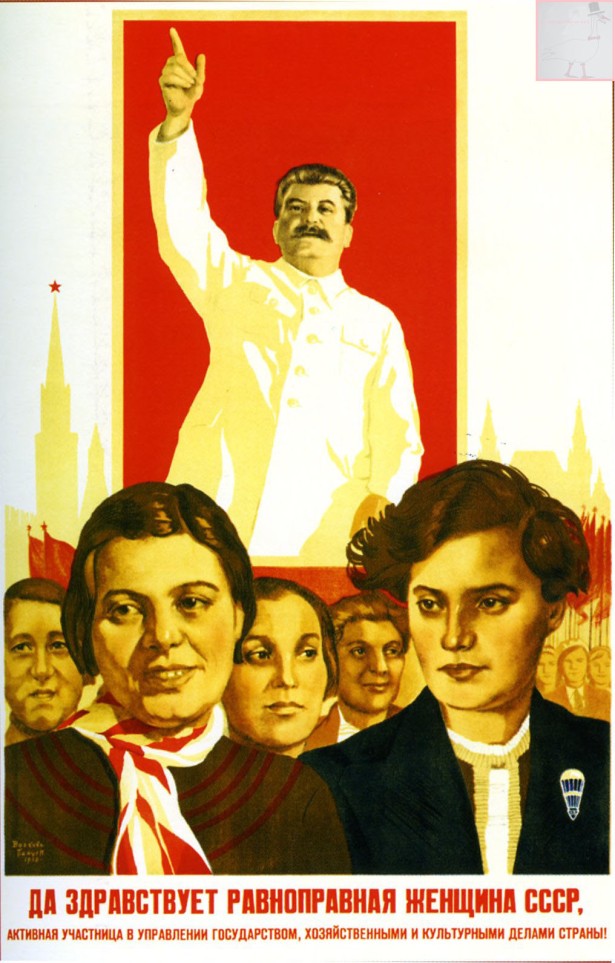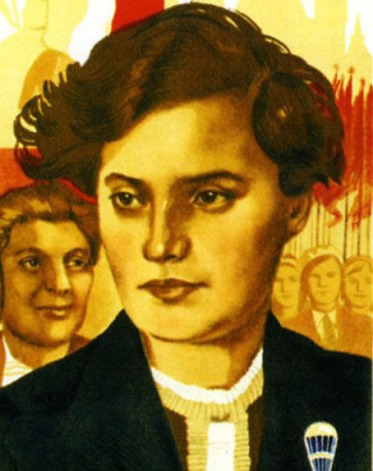
Marina Volkova and Natalia Pinus (Марина Волкова и Наталья Пинус), Long Live the Equal-Rights Woman in the USSR, an Active Participant in the Administration of the Nation’s State, Economic, and Cultural Affairs! (да здравствует равноправная женщина СССР! активная участница в управлении государством, хозяйствеными, и культурными делами страны!) ,1938
Stalin poster of the week is a weekly excursion into the fascinating world of propaganda posters of Iosif Stalin, leader of the USSR from 1929 until his death in 1953.
Here, Anita Pisch will showcase some of the most interesting Stalin posters, based on extensive research in the archives of the Russian State Library, and analyse what makes these images such successful propaganda.
Anita’s new, fully illustrated book, The personality cult of Stalin in Soviet posters, 1929 -1953, published by ANU Press, is available for free download here, and can also be purchased in hard copy from ANU Press.
The 1938 poster, ‘Long live the equal-rights woman in the USSR, an active participant in the administration of the nation’s state, economic, and cultural affairs!’ was created by two well-established female poster artists, Marina Volkova and Natalia Pinus.
Although the subject of the poster is the new equality of women, as evidenced by high-flying women achievers in state, economic and cultural affairs, it is the figure of Stalin that dominates the poster, occupying two-thirds of the space, engulfed in a sea of holy and revolutionary red.

Although this poster is about Soviet women, Stalin occupies two-thirds of the picture plane
The colour red is specifically associated with icons, where it often forms a background colour and represents youth, beauty and eternal life and, in posters, it imbues the figures it surrounds with an aura of sacrality.
The ‘woman delegate’ became something of an archetype in Soviet painting during the mid-1930s. Almost all Soviet delegates were women, and this was part of a trend in which the image of the female came increasingly to represent the stereotypic ‘Soviet citizen’ in visual culture and women were depicted in propaganda and the media submitting to authority figures, learning, and expressing gratitude.
The colour palette of the poster, the use of tone and the flat, stylised image of Stalin, all echo the Russian Orthodox icon. Like a holy personage, Stalin is the source of light in the poster. Dressed in white, with gold tones, he casts a golden hue over the entire poster, including the faces of the young women.

The young female delegates are bathed in Stalin’s golden light
The familiar shape of the Spassky tower of the Moscow Kremlin is silhouetted in Stalin’s golden light, rising into empty space to his right, the spire topped with a red star echoes his upraised arm and gesturing golden hand and forms a sort of Soviet house of worship or sacred site.
This poster is manifestly about the new order and the new creation. The new order is symbolised by the sea of red flags on either side of the women, and also by the Kremlin.

This serious young parachutist does not engage the viewer, looking instead to the imminent utopian future
It is particularly manifest in the army of modern, professional young women, their ranks receding into the background. Though slim and attractive, there is nothing coy or frivolous about these women. They are allowed, at best, an ambiguous half-smile, and the focus is on their eyes, which do not engage the viewer, but look out of the picture and around the viewer, to the imminent future.
The woman in blue is a parachutist, literally accessing the heavens under the new order. Stalin points upward and out of the picture frame, to the heaven-on-earth of the communist utopia
This poster visually references the colour, tonal qualities and stylised imagery of the Russian Orthodox icon, a visual language with which the Soviet population were familiar, and encourages a subconscious spiritual response to the poster.
Anita Pisch‘s new book, The personality cult of Stalin in Soviet posters, 1929 – 1953, is now available for free download through ANU Press open access, or to purchase in hard copy for $83. This lavishly illustrated book, featuring reproductions of over 130 posters, examines the way in which Stalin’s image in posters, symbolising the Bolshevik Party, the USSR state, and Bolshevik values and ideology, was used to create legitimacy for the Bolshevik government, to mobilise the population to make great sacrifices in order to industrialise and collectivise rapidly, and later to win the war, and to foster the development of a new type of Soviet person in a new utopian world.
